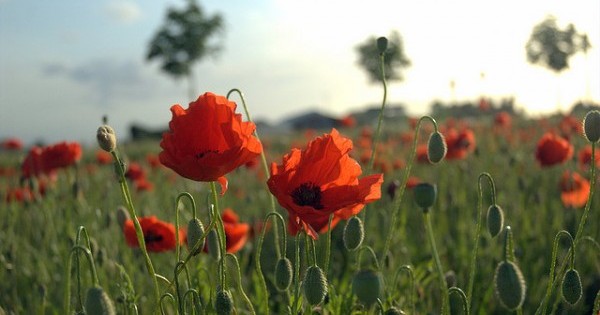
Red poppy, white poppy, purple poppy: every autumn, during the 11 days or so leading up to Armistice Day on November 11, people in Britain wear a variety of paper-and-plastic poppies to commemorate those who died on the killing fields of World War I. The most popular is the red poppy, first worn and sold by an American woman, Moina Michael. She was inspired by the words of Canadian Lieutenant-Colonel John McCrae’s popular 1915 poem, “In Flanders Fields,” that begins:
In Flanders Fields, the poppies blow
Between the crosses, row on row, …
Wearing of white poppies was first introduced in 1933 by the British Women’s Co-operative Guild as a protest against war and as “a symbol of grief for all people of all nationalities, armed forces and civilians alike, who are victims of war.” Some women were fired from their jobs for wearing it, and white poppy wreaths have been torn from memorials and trampled. Wearing the purple poppy, a recent addition to the commemoration bouquet, began in 2006 in remembrance of animal victims of war. According to the Imperial War Museum in London, more than 16 million animals “served in the First World War,” including carrier pigeons, poison-gas detecting canaries, horses and camels that hauled food, guns, and medical supplies, and cats and dogs trained to hunt rats in trenches.
The red poppy, Papaver rhoeas, grows wild in the fields of northern France and Belgium. A modern visitor to Flanders fields might therefore expect to see a glorious spread of red flowers each spring. In fact, the opposite is true, says ecologist Nina Hautekèete of the University of Lille in Northern France. She has found that the richness of plant species in the region “has changed drastically” since the beginning of the 20th century, with many wild species declining or going extinct.
The poppy, “a symbolic species that we all have in mind when thinking of fields, is representative of what is happening,” Hautekèete wrote to me via email. “It is now quite difficult to find poppies in our fields, even if the species is still present.” She and her colleagues, who presented their findings at a recent meeting in Lille of the British Ecological Society, have found that plant biodiversity in Northern France and Belgian Flanders has increased over the past century. But that is in part due to arrival of invasive species—some of them toxic escapees of urban gardens.
“Although the species richness is increasing, about one-fifth of the species in these regions are either locally new or have gone extinct during the last century, which is a major change,” Hautekèete told me. Among the newly introduced species are creeping water primrose (Ludwigia peploides), an aquatic species that can choke waterways, and giant hogweed (Heracleum mantegazzianum), a “tall, extremely impressive, and quite beautiful” parsnip relative planted in parks and private gardens. Its toxic sap can trigger skin irritation and blisters. (“You’d better not touch them,” Hautekèete warns.)
The loss of wild species such as field-larkspur (Consolida regalis) and the summer pheasant’s-eye (Adonis aestivalis) is due to intensive farming, she says. Use of fertilizers and weed killers has sped the species’ disappearance, and urban development has destroyed fragile bogs where insect-eating plants like spoonleaf sundew (Drosera intermedia) once grew. “The rise in the number of plant species is not good news,” Hautekèete notes. “Instead, the findings highlight increasing globalization and homogenization of local environments as invasive species arrive and more diverse, specialized species become extinct.”
While the iconic red poppy may be disappearing from Flanders fields, it still continues to inspire works of art such as Blood Swept Lands and Seas of Red, an installation of 888,246 ceramic poppies—one for every soldier in the British forces killed during the First World War—“planted” last year from August to November at the Tower of London. The installation, by Paul Cummins and Tom Piper, drew vast crowds—and a visit from Queen Elizabeth—during its tenure. But not everyone was favorably impressed by the display. The prettified scene, argued art critic Jonathan Jones, belied the horror of World War I. “A meaningful mass memorial … would be gory, vile and terrible to see,” he wrote in The Guardian. “The moat of the Tower should be filled with barbed wire and bones.”

